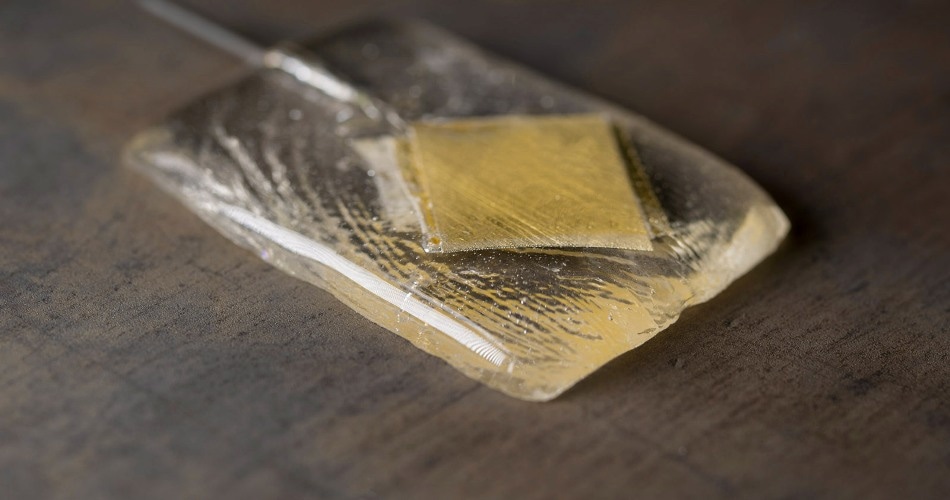May 3 2017
 High-temperature ultrasonic transducer. Copyright Photo Fraunhofer ISC
High-temperature ultrasonic transducer. Copyright Photo Fraunhofer ISC
It is essential to regularly check for defects, such as cracks, in technical systems. Till date, piezo sensors measuring pressure, voltage or force have been used to consistently detect such faults, but only to around 200 oC. Now, components that are as hot as 900 oC can be continuously monitored by special high-temperature piezo sensors.
Fraunhofer researchers will present their development at the SENSOR+TEST measurement fair that will be taking place in Nürnberg from May 30 to June 1, 2017 (Hall 5, Booth 248).
Repairing a component, such as a steam pipe in a coal-fired power station, is imperative if it has corrosion, a crack or any other flaw. Such flaws can be detected by ultrasonic sensors mounted externally, but only when the component does not heat up to more than around 200 degrees Celsius. If that temperature exceeds, standard piezoelectric materials will no longer determine force, pressure, acceleration or voltage or act as a gas sensor. In addition to this, at these temperatures any plastic encapsulations that are not heat-resistant will fail.
First sensors for high-temperature applications
Piezo sensors for high-temperature applications have currently been successfully realized by researchers at the Fraunhofer Institute for Silicate Research ISC.
We have already implemented our sensors at temperatures of up to 600 degrees Celsius. Generally speaking, temperatures of up to 900 degrees Celsius are possible.
Dr. Bernhard Brunner, Head of Application Technology Department, Fraunhofer ISC’s Center Smart Materials
Additionally, the ultrasonic sensors continue to be stable over prolonged periods – at least two years in any use case – and for a number of applications, researchers expect a service life of more than a few decades. The same principle is applied for other piezo sensors: they are mounted externally on the component, for example on a hot steel pipe. The piezoelectric crystal mechanically deforms and sends an ultrasonic wave into the material when an alternating voltage is applied to it. The sensor switches to receive and detects the signal reflected by the component after the sound wave. In most cases, the same original signal it sent is received. The defect alters the reflected signal and indicates the defect’s location, if the component has a corroded spot or is cracked. When several transducers are used that serve as receiver and transmitter, the location of the flaw can be accurately pinpointed to within a few millimeters. The sensor’s range covers a few meters based on the component’s material.
The challenge lies in building standard piezoelectric crystals capable of withstanding long-term use as sound transducers on hot components. Particularly problematic is the adhesive that coats the sensors and fixes them to the component: it cannot withstand extremely high temperatures. “That’s why we use glass solder as both a glue and a housing material,” explains Brunner. This highlights the fact that the glass belonging to this group of adhesives must be able to withstand not only heat, but also the several hundred degrees Celsius difference between the operating temperature of the component and the ambient temperature in the room. The steel in the component expands majorly when it is heated, and the dimensions of the crystal change only marginally. It is essential for the glass solder in which the sensor is embedded to endure these deformations without shattering. To this end, the researchers coat the sensor with multiple layers consisting of varied glass solders that are flawlessly compatible with each other as well as with the component’s material specifications. The corresponding glass solders and also the process technology and processing technique all come from Fraunhofer ISC. The feed lines are made of precious metals such as platinum in order to guarantee that the electric signaling lines do not corrode in high temperatures.
Broad range of applications
A number of possible applications are available for the high-temperature ultrasonic transducer: for instance, the researchers can also use their sensors for contactless measurements of how much of a hot liquid, such as oil, passes through a pipe or of the temperature of a liquid or a gas. The ultrasonic transducer has the potential to provide a result within a few milliseconds, while a probe takes a few seconds to determine the exact temperature. It is capable of measuring temperature based on sound velocity, which is temperature dependent. The scientists will present prototypes of their sturdy sensor sleuths at the SENSOR+TEST measurement fair in Nürnberg, May 30 to June 1, 2017 (Hall 5, Booth 248).